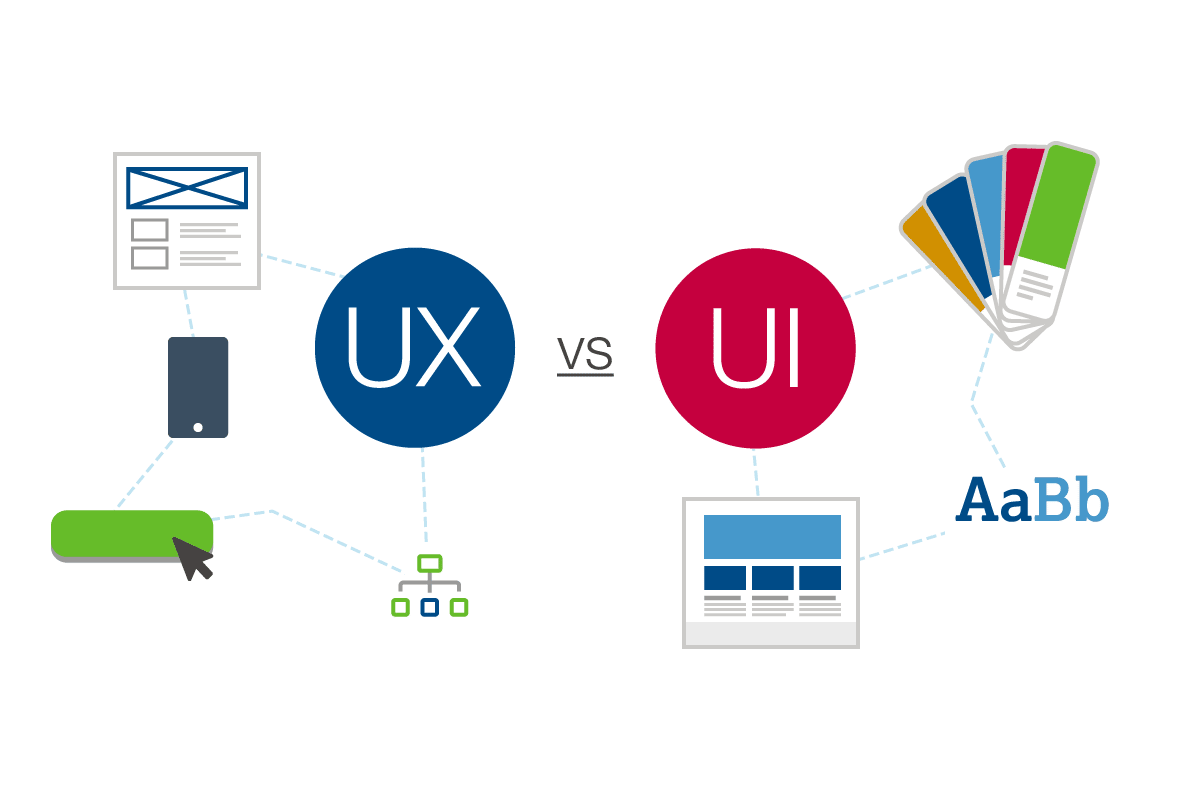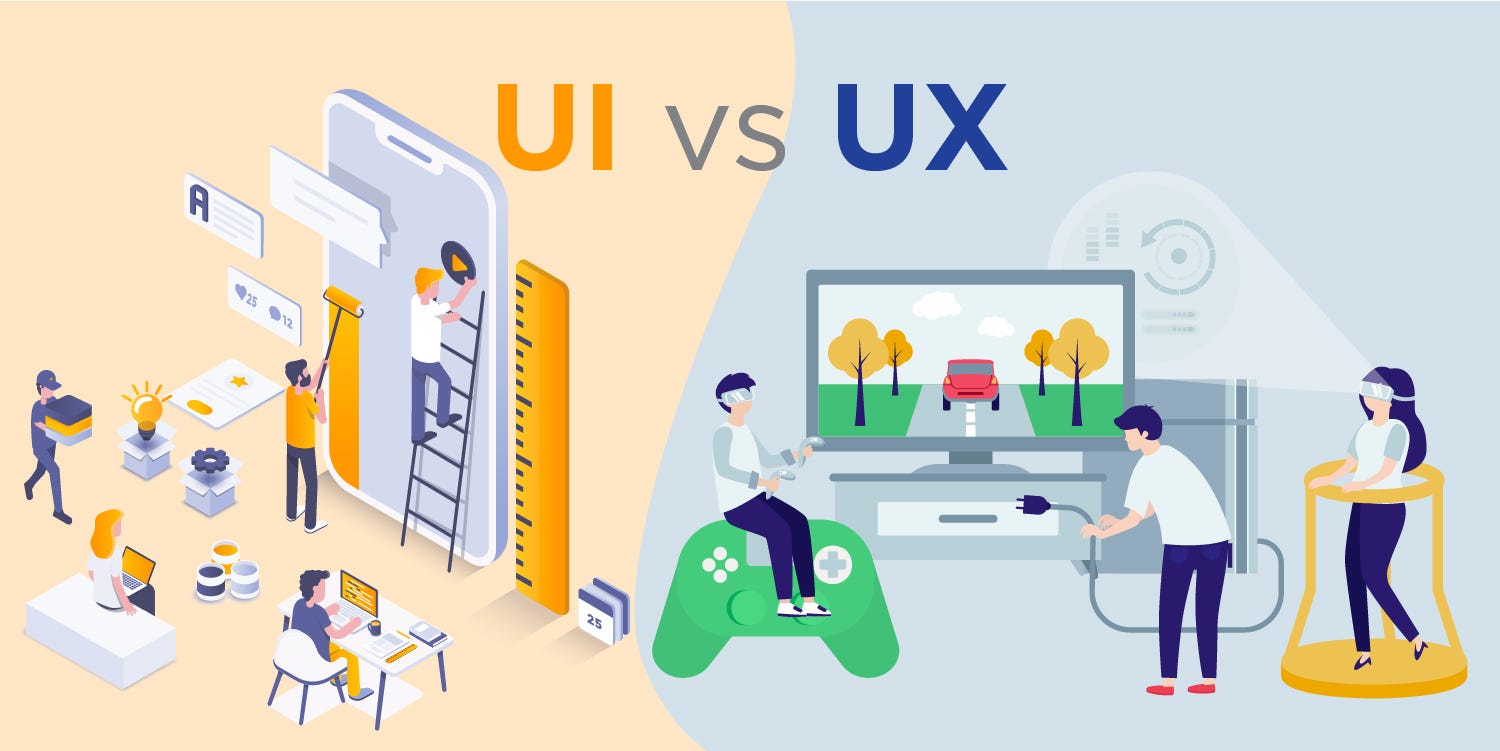
UI and UX are often used interchangeably, but they are not the same! Though both hold equal importance, they have different purposes. If you’re interested in learning the difference between UI vs UX design, you’ve landed at the right place.
In this article, we’ll talk about UI vs UX design in detail. We’ll cover similarities and differences between the two terms. And will also discuss the job roles of user interface designers and user experience designers. So keep reading!
Have you ever visited a website that seemed..boring and plain to you? Well, that’s probably because the company did not hire a good User interface (UI) designer for website development.
The role of user interface designers is often considered to be fun since they focus on the visual elements of the website. UI designers aim to make the product visually appealing, engaging, and interactive for the users.
They are responsible for implementing different visual elements in the website including icons, logos, buttons, color schemes, etc. In short, UI designers focus on how something looks.
UI-vs-UX-Design

The typical tasks carried by a User interface designer include:
Design research
It involves researching competitors and trending design to get a better idea about customer expectations. Research not only helps designers find inspiration, but also helps them create effective interfaces.
It focuses on implementing colors, icons, fonts, and texts to improve the overall design of the product. In short, under visual design, UI designers focus on the aesthetics of the product.
Branding and graphic development
Branding in the user interface refers to setting visual elements to define your brand style. The UI designer is responsible for creating a unique feel to the brand through colors, typography, templates, and other graphic elements, all of which would help in creating a brand identity.
Interactivity and animation
UI designers create interest-raising elements such as transitions, animations, and GIFs . These elements make the website/app more interactive and engaging for users.
Design responsiveness
The design needs to be accessible and usable on all devices and screen sizes. Here, the role of the designer is to make sure that the content fits smoothly in the browser space available.
The role of user experience designers is to make the website or application easy to use and intuitive for the users. Unlike the role of UI designers, UX designers don’t focus on the visual aspects of the product. Instead, they work on other aspects of product development such as function, usability, testing, branding, and even marketing. In simple words, UX designers focus on how something works.
The typical tasks carried out by a User experience designer include:
Plan
Before creating the product, UX designers develop a strategy that needs to be followed through the development process. This ensures that the stakeholders and designers are on the same page.
User research
It involves studying and researching data on the target audience, customer needs, user behavior and expectations, etc.
Information architecture
Information architecture defines how the content on your website or app will be presented to the users. It is usually created by designers before the actual designing process begins.
Creating the user flow
Since user experience development involves understanding the needs of the customers who will use the product, UX developers are responsible for creating a user flow that would streamline the whole process.
Wire framing
Wire framing refers to the process of designing a visual skeleton of the website/app. It is like the foundation of the product, which helps designers to display elements in the best way possible.
Prototyping
The purpose of prototyping is to test the product in real-time and collect feedback on it. This allows UX designers to determine what the end-user would experience upon using the product
Testing
Before finalizing the product, it is essential to ensure that it has been created correctly. Testing allows designers to test the product in real-time to help them complete the previous development phase before they move onto the next one.
For more information, visit: QUALITIES OF A GREAT DEVELOPER: READ WHAT MAKES A DEVELOPER GREAT
Though there are many differences between UI vs UX design – one simply can’t function properly without the other. For a successful website or app, equal importance needs to be paid to both UI and UX. User experience determines where the audience using the website or app wants to go and the user interface helps them get there.

No matter how eye-catching the user interface is, it would be useless without user experience development since users won’t be able to properly interact with the product. Likewise, regardless of how effective the UI is – without an attractive and engaging UX, people wouldn’t be interested in checking out your website.
“Something that looks great but is difficult to use is exemplary of great UI and poor UX. While something very usable that looks terrible is exemplary of great UX and poor UI.” – Helga Moreno
You might also want to read: HOW MUCH DOES A WEBSITE REDESIGN COST? TIPS TO CALCULATE BUDGET
Rather than thinking of UX and UI designers as two separate professions, consider them as two different skills needed for a project. So how exactly do you determine whether you need a UI designer or a UX designer for your projects? Let’s see:
Though there are designers out there that are experienced in both UI and UX development, the ideal approach is to hire separate designers for both. This is because both roles involve different working strategies and tools. Asking the same designer to work on both will not only make the product development process much longer and complex, but would also reduce the level of productivity.
Since UX designers are responsible for the outcome of the product, they are involved in managing different tasks at the same time ensuring that the value of the product is not compromised during the process.
Whereas, UI designers are technically responsible for only one aspect of the product, ensuring that it is visually appealing and engaging.
Hence, a single designer can’t simultaneously focus on creating an effective interface and researching the wants and needs of the end-users. Hiring a single designer for both roles can increase the chances of scope creep, resulting in management chaos. Therefore, to ensure the success of the product, you must hire different designers for both roles.
So, UI Designer or UX Designer? Both are equally important, but they have different roles to play in a project. A UI Designer’s job is focused on improving how users interact with your product or service, whether that be through an app, website, desktop software or anything else.
The UX Designer does this too, but their focus tends to be more about understanding user needs and behavior patterns before designing solutions for them.
If you’re still having trouble deciding, then: Contact Us! We can help you find out which one of these designers you need by answering all those questions you might have.
Comments (0)